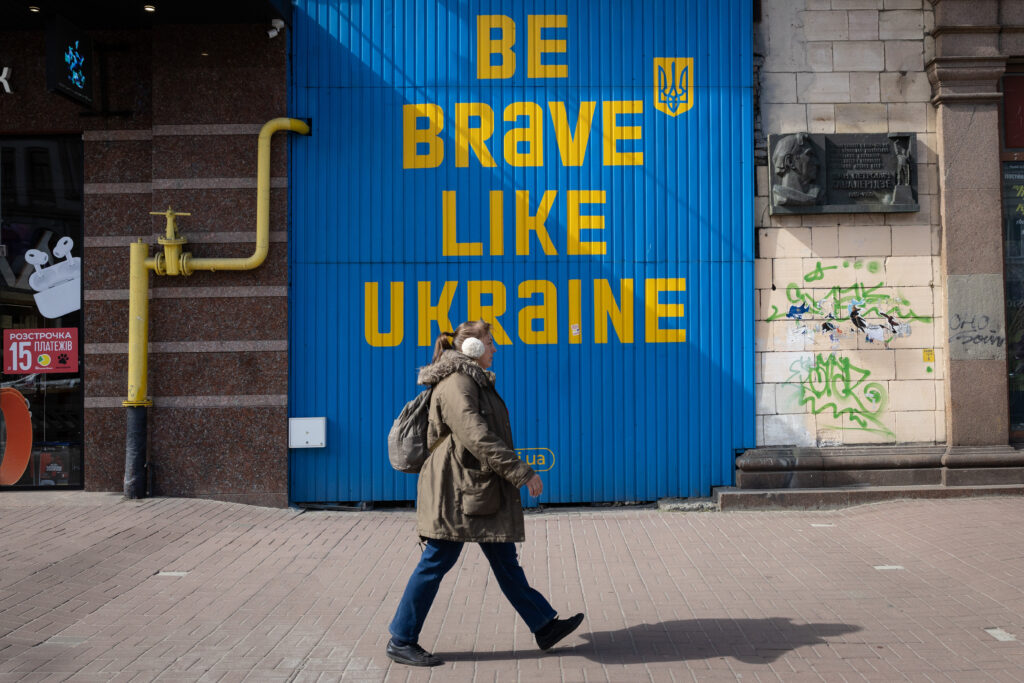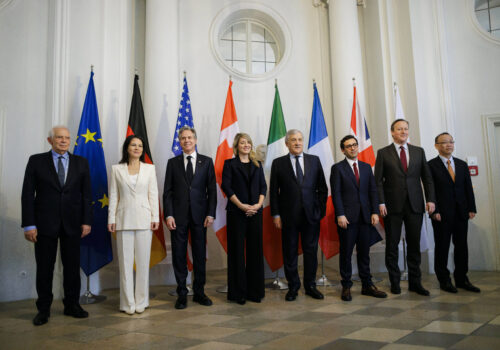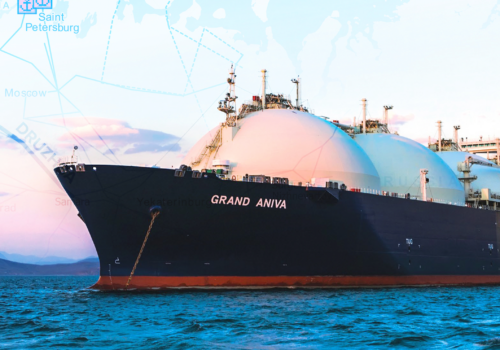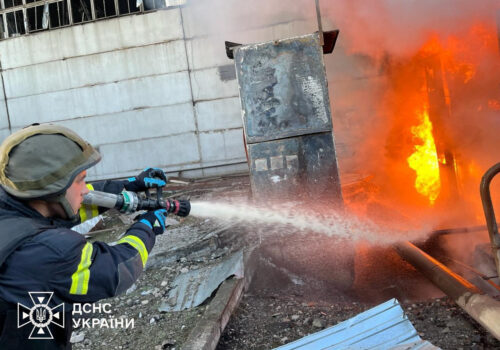Dispatch from Kyiv: Ukraine is fighting for its economic survival, too
Imagine a country exporting nearly 90 percent of the wheat and corn it did before losing control of a sixth of its territory. Consider facing daily air raids targeting vital infrastructure while still keeping the lights on and the internet running. These are some of the many impressive achievements of the Ukrainian economy in the two years since Russia’s full-fledged invasion.
Keeping this up is a daily, expensive challenge. For just a few thousand dollars apiece, Russia buys kamikaze drones from Iran that do millions of dollars of damage. Ukraine is using air defenses sparingly because of uncertainties surrounding how long Western military and financial support will last. Kyiv and its backers tend to say that reconstruction cannot wait for the war to end. But when cash becomes sparse, as it has recently, resources will clearly go to the war effort and urgent basic services first.
On our recent research trip to Kyiv, we were struck not only by the size of the challenges, but also by the encouraging coherence of nascent strategies meant to deal with them. Ukrainian officials and civil society are demonstrating the plucky and determined resolve that has characterized Ukraine’s heroic fight against the invading forces. The problem is that, quite like on the battlefield, they haven’t been provided with all the tools for success.
It’s already clear that the longer the war lasts, the more it will consume funds initially meant for long-term investments.
Earlier this year, prevarication by the US Congress over supplemental funding combined with farmers’ and truckers’ protests at Ukraine’s borders triggered cash flow problems. If Japan hadn’t acted by bringing forward two donations of just under half a billion dollars, which had been scheduled for later, Kyiv would have struggled to pay soldiers’ salaries in March and April. The government now has a little more visibility for the months to come, as the first 4.5 billion euro tranche from the European Union’s (EU) Ukraine Facility was disbursed in March, as well as two billion Canadian dollars in financial assistance from Ottawa.
The EU funds are meant to “provide predictable financial support to help Ukraine in its recovery, reconstruction, and modernization,” but this first tranche will most likely end up funding the Ukrainian state budget—some of which will go to repairs to civilian infrastructure, but not all. It’s already clear that the longer the war lasts, the more it will consume funds initially meant for long-term investments.
Despite dwindling stockpiles, Ukraine has demonstrated impeccable efficiency and precision in repelling attacks and maintaining critical systems. This was on display in the Dnipropetrovsk region in March when electricity systems were quickly recovered after Russian drone and missile strikes. But recent attacks on critical energy infrastructure in Kharkiv (where most of the energy infrastructure has been destroyed), Kyiv, Zaporizhzhia, Odesa, and Lviv must be a wake-up call to US leaders to pass a supplemental aid package now. Every day that additional US military aid is delayed, Ukraine incurs loss of life and millions in damages, increasing already massive reconstruction costs.
So, what does Ukraine need now for its economic survival? To start with, more certainty that its air defenses will continue to be supplied would help Ukraine move to more long-term planning on reconstruction. For now, insurance contracts—though heavily subsidized by Western governments and international financial institutions—can only cover shipments lasting a few short weeks. The much–vaunted solution of “war insurance” covering the risk the private sector would take by investing in Ukraine requires contracts lasting several decades. That will only become possible if air strikes become less frequent and less damaging. Before moving in, investors also need more visibility on how they will be able to move their return on investment out of Ukraine. The National Bank of Ukraine’s strict capital controls are justified given uncertainties over cash flow. But clarity on the conditions under which these will be lifted would be helpful.
In addition to more funding sources for Ukraine, a revitalized Ukrainian economy will also provide benefits to Western economic security. Restored mining capacities can replace the titanium countries used to buy from Russia. With the right tools, the mighty agricultural sector can continue to diversify into biomass energy and sell more into the EU single market without upsetting its farmers.
There is potential in every region of Ukraine. For now, it is still up to Ukraine’s backers to provide enough certainty on weapons and immediate financial assistance to make it possible to tap into that potential. It was heartening to see that the major players all traveled to Kyiv this week to be represented at the Steering Committee of the Multi-agency Donor Coordination Platform. It is now likely Kyiv will avoid major cash-flow issues for the rest of 2024. Let’s hope the picture on weapons—still the key ingredient to unlock long-term projects to revitalize Ukraine’s economy—has improved by the Ukraine recovery conference in Berlin in June. Otherwise, the conference will suffer the same fate as its London predecessor: a succession of sympathetic statements from the private sector, but nothing concrete.
Olga Khakova is the deputy director for European energy security at the Atlantic Council’s Global Energy Center.
Charles Lichfield is the deputy director and C. Boyden Gray senior fellow of the Atlantic Council’s GeoEconomics Center.
Further reading
Fri, Feb 23, 2024
Russia’s blocked assets: A ‘non-collateral collateral’ plan could be the way forward
New Atlanticist By Charles Lichfield
Instead of seizing Russia’s immobilized sovereign assets outright, G7 members seem instead to be aligning around “unlocking their value.”
Thu, Mar 14, 2024
Reducing Europe’s reliance on Russian energy imports: Key strategies under five scenarios
Report By Richard L. Morningstar, András Simonyi, Olga Khakova, Paddy Ryan
To better understand how the war’s conclusion—or lack thereof—will impact the options available to transatlantic policymakers, this report analyzes European security across five general scenarios—a Ukrainian victory, a negotiated settlement, a frozen conflict, a protracted conflict, and a Russian victory.
Thu, Apr 11, 2024
Ukraine pleads for Patriot air defense systems as Russia destroys power grid
UkraineAlert By Peter Dickinson
Officials in Kyiv are calling on partners to urgently supply Patriot systems as Russia capitalizes on Ukraine’s weakening air defenses to methodically destroy the country’s power grid, writes Peter Dickinson.
Image: A woman walks near a building with a huge inscription ‘Be brave like Ukraine’ in central Kyiv. Ukrainian capital is located away from the fighting places, but the presence of war is felt in the city and affects many aspects of the life of local residents. Russian troops entered Ukrainian territory on February 2022, starting a conflict that provoked the destruction of areas and humanitarian crisis.



